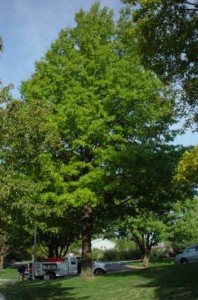Importance of Caring for Your Trees
 You should think of your trees as being an investment in your property. Healthy trees will increase in value as they age. Not only will they increase the value of your home, but they will beautify your surroundings, save you energy by providing you with shade during the warm summer months, purify the air and protect you from the harsh winds in the winter.
You should think of your trees as being an investment in your property. Healthy trees will increase in value as they age. Not only will they increase the value of your home, but they will beautify your surroundings, save you energy by providing you with shade during the warm summer months, purify the air and protect you from the harsh winds in the winter.
By providing your landscaping with a preventative care program, you are essentially putting money back in the bank. Regular maintenance is designed to promote the health of your plants and restore their vigor, thus, ensuring their value is only going to continue growing. Preventing problems will end up costing you a lot less money and time than what it will to try and correct one that has already developed.
Effective maintenance programs, such as regular inspections and all of the necessary follow-up care such as fertilizing, pruning and mulching, can help to detect any problems and correct them before they have the chance to damage the tree. When you consider that there are a number of different tree species that can live upwards of 200-300 years, you want to do everything you can to protect your landscaping. The investment is going to provide you with value and enjoyment for years to come.
Inspecting the tree is an important tool to bringing attention to any changes in the health of the tree before the issue becomes too severe. By having a regular inspection of any mature trees at least once per year, you can help to reduce or prevent any severe future diseases, environmental issues and inset problems. During the inspection, make sure to have the four characteristics of vigor examined: twig growth, new leaves or new leaf buds, absence of any crown dieback and leaf size.
If you notice there aren’t as many new shoots, you can safely assume that the health of the tree has changed recently. To help evaluate this factor, you need to compare the growth of any shoots for the past three years. Try to determine if there is a reduction in the growth pattern of the tree.
Other signs to look for that indicate poor health are crown dieback, trunk decay or both. These symptoms are often indicative of a problem that began a few years ago. Deformed growths and loose bark are other signs that there is decay in the tree.
If there are any abnormalities found at one of your inspections, you want to monitor them closely. Dead leaves, spots, deformities, discolored leaves and dead twigs are all things that you need to pay attention to and make sure the problem doesn’t continue to get worse as the days go by.
